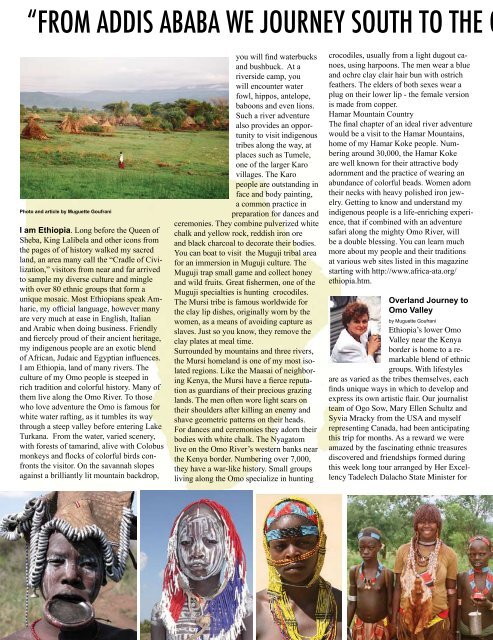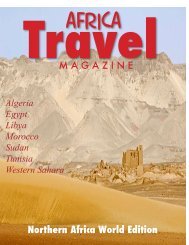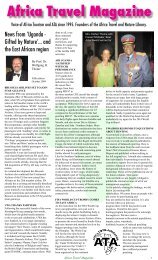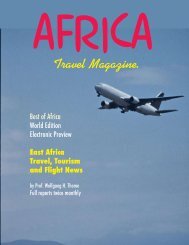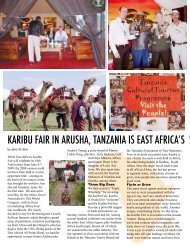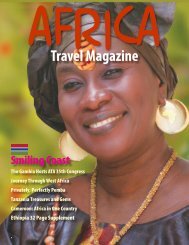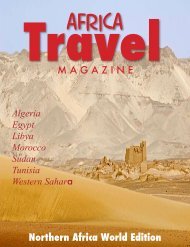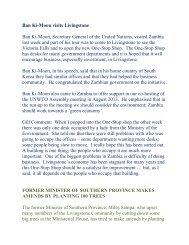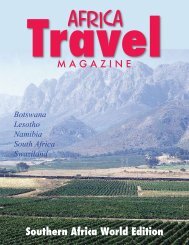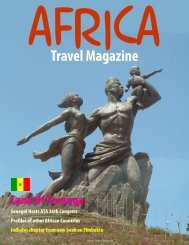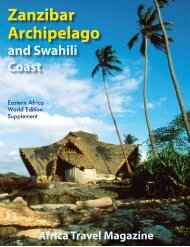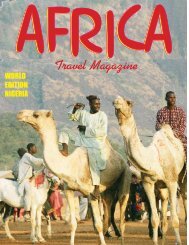ETHIOPIA MILLENNIUM EDITION - Travel Magazine
ETHIOPIA MILLENNIUM EDITION - Travel Magazine
ETHIOPIA MILLENNIUM EDITION - Travel Magazine
You also want an ePaper? Increase the reach of your titles
YUMPU automatically turns print PDFs into web optimized ePapers that Google loves.
“FROM ADDIS ABABA WE JOURNEY SOUTH TO THE O<br />
Photo and article by Muguette Goufrani<br />
I am Ethiopia. Long before the Queen of<br />
Sheba, King Lalibela and other icons from<br />
the pages of of history walked my sacred<br />
land, an area many call the “Cradle of Civilization,”<br />
visitors from near and far arrived<br />
to sample my diverse culture and mingle<br />
with over 80 ethnic groups that form a<br />
unique mosaic. Most Ethiopians speak Amharic,<br />
my official language, however many<br />
are very much at ease in English, Italian<br />
and Arabic when doing business. Friendly<br />
and fiercely proud of their ancient heritage,<br />
my indigenous people are an exotic blend<br />
of African, Judaic and Egyptian influences.<br />
I am Ethiopia, land of many rivers. The<br />
culture of my Omo people is steeped in<br />
rich tradition and colorful history. Many of<br />
them live along the Omo River. To those<br />
who love adventure the Omo is famous for<br />
white water rafting, as it tumbles its way<br />
through a steep valley before entering Lake<br />
Turkana. From the water, varied scenery,<br />
with forests of tamarind, alive with Colobus<br />
monkeys and flocks of colorful birds confronts<br />
the visitor. On the savannah slopes<br />
against a brilliantly lit mountain backdrop,<br />
you will find waterbucks<br />
and bushbuck. At a<br />
riverside camp, you<br />
will encounter water<br />
fowl, hippos, antelope,<br />
baboons and even lions.<br />
Such a river adventure<br />
also provides an opportunity<br />
to visit indigenous<br />
tribes along the way, at<br />
places such as Tumele,<br />
one of the larger Karo<br />
villages. The Karo<br />
people are outstanding in<br />
face and body painting,<br />
a common practice in<br />
preparation for dances and<br />
ceremonies. They combine pulverized white<br />
chalk and yellow rock, reddish iron ore<br />
and black charcoal to decorate their bodies.<br />
You can boat to visit the Muguji tribal area<br />
for an immersion in Muguji culture. The<br />
Muguji trap small game and collect honey<br />
and wild fruits. Great fishermen, one of the<br />
Muguji specialties is hunting crocodiles.<br />
The Mursi tribe is famous worldwide for<br />
the clay lip dishes, originally worn by the<br />
women, as a means of avoiding capture as<br />
slaves. Just so you know, they remove the<br />
clay plates at meal time.<br />
Surrounded by mountains and three rivers,<br />
the Mursi homeland is one of my most isolated<br />
regions. Like the Maasai of neighboring<br />
Kenya, the Mursi have a fierce reputation<br />
as guardians of their precious grazing<br />
lands. The men often wore light scars on<br />
their shoulders after killing an enemy and<br />
shave geometric patterns on their heads.<br />
For dances and ceremonies they adorn their<br />
bodies with white chalk. The Nyagatom<br />
live on the Omo River’s western banks near<br />
the Kenya border. Numbering over 7,000,<br />
they have a war-like history. Small groups<br />
living along the Omo specialize in hunting<br />
crocodiles, usually from a light dugout canoes,<br />
using harpoons. The men wear a blue<br />
and ochre clay clair hair bun with ostrich<br />
feathers. The elders of both sexes wear a<br />
plug on their lower lip - the female version<br />
is made from copper.<br />
Hamar Mountain Country<br />
The final chapter of an ideal river adventure<br />
would be a visit to the Hamar Mountains,<br />
home of my Hamar Koke people. Numbering<br />
around 30,000, the Hamar Koke<br />
are well known for their attractive body<br />
adornment and the practice of wearing an<br />
abundance of colorful beads. Women adorn<br />
their necks with heavy polished iron jewelry.<br />
Getting to know and understand my<br />
indigenous people is a life-enriching experience,<br />
that if combined with an adventure<br />
safari along the mighty Omo River, will<br />
be a double blessing. You can learn much<br />
more about my people and their traditions<br />
at various web sites listed in this magazine<br />
starting with http://www.africa-ata.org/<br />
ethiopia.htm.<br />
Overland Journey to<br />
Omo Valley<br />
by Muguette Goufrani<br />
Ethiopia’s lower Omo<br />
Valley near the Kenya<br />
border is home to a remarkable<br />
blend of ethnic<br />
groups. With lifestyles<br />
are as varied as the tribes themselves, each<br />
finds unique ways in which to develop and<br />
express its own artistic flair. Our journalist<br />
team of Ogo Sow, Mary Ellen Schultz and<br />
Syvia Mracky from the USA and myself<br />
representing Canada, had been anticipating<br />
this trip for months. As a reward we were<br />
amazed by the fascinating ethnic treasures<br />
discovered and friendships formed during<br />
this week long tour arranged by Her Excellency<br />
Tadelech Dalacho State Minister for


